Mimic Octopus
Thaumoctopus mimicus
The mimic octopus is best known for… well, being a mimic! It imitates all kinds of other sea creatures, from flatfishes to sea snakes to anemones. It can also match its color scheme to those creatures (when it doesn’t feel like wearing its distinctive stripes).
Mimics are also subterranean experts. They can dig burrows, navigate underground tunnels, and even blindly stick their arms into holes in search of snacks!
Size
19 in long (48 cm)
Lifespan
1-2 years
Habitat
Shallow seas - sand, silt
Diet
Worms, echinoderms, crustaceans, fishes
Range
Tropical southwestern Pacific Ocean
Predators
Golden trevally and other fishes
superpower
Shapeshifting
This octopus uses its arms to expertly mimic the shape and swimming motions of other sea creatures.
SCIENTIFIC NAME: Thaumoctopus mimicus
This is the only species in this genus! It was first discovered in 1998 as the mimic octopus and was named Thaumoctopus mimicus in 2005!
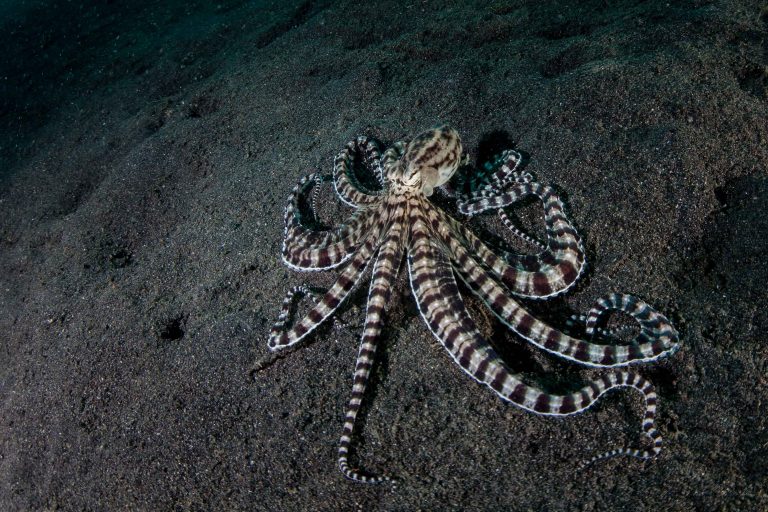
SIZE OF THE MIMIC OCTOPUS
This is a moderate-sized species with a mantle length to 58 mm (2 in), and total length to over 480 mm (19 in). The arms are long and thin and can be 7-10x the mantle length with 283 suckers on normal arms.
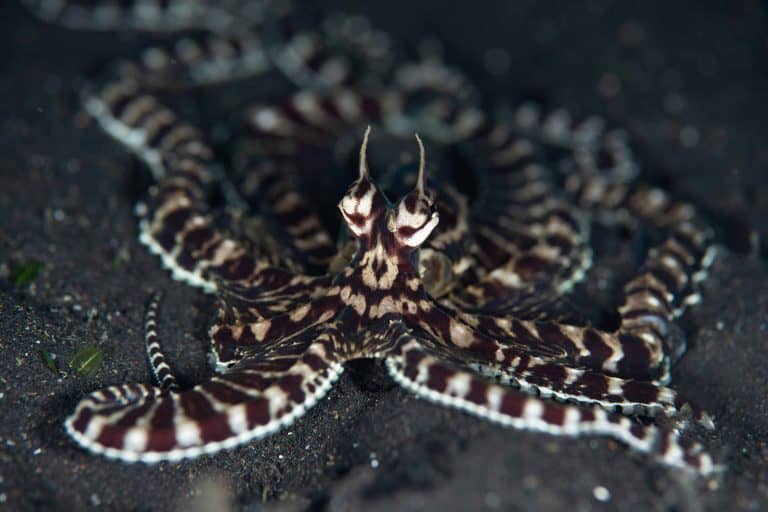
MIMIC OCTOPUS LIFESPAN
The lifespan of this species is unknown, but it likely lives for 1-2 years.
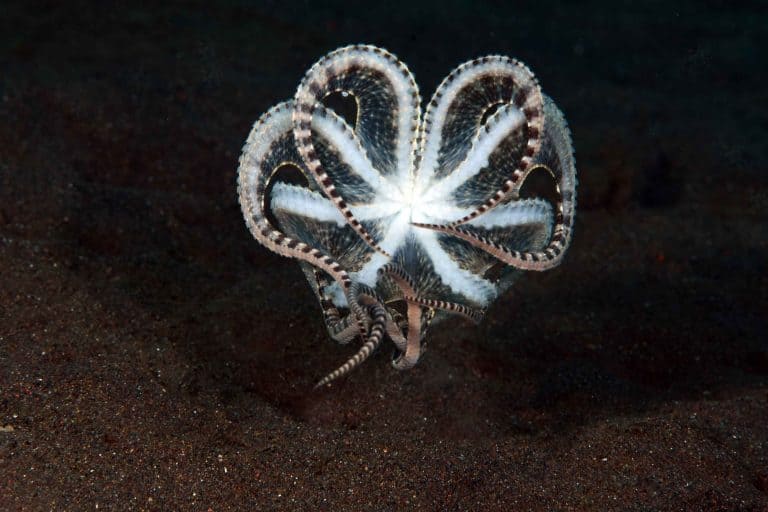
DISTRIBUTION
Discovered off the coast of Sulawesi, Indonesia, this species range is the tropical Indo-West Pacific from north-east Australia (Lizard Island), New Caledonia, and Papua New Guinea, through Indonesia, north to the Philippines, and west to the Red Sea.
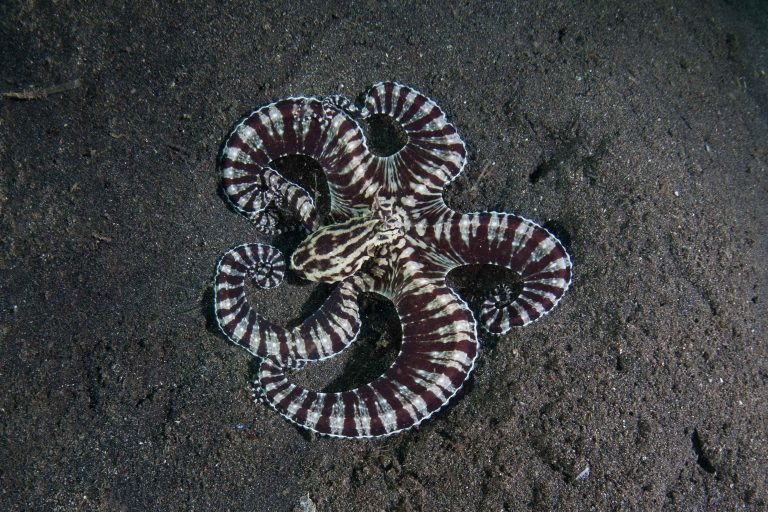
HABITAT
This is a shallow water octopus inhabiting coastal water on soft sediment (silt or sand substrate) in water from 0.5 m (1.5 ft) to at least 37 m (121 ft). The mimic is capable of creating its own burrow/ den with its long arms in soft substrate or will use burrows created by other animals (crabs, fishes, worms) as its home.
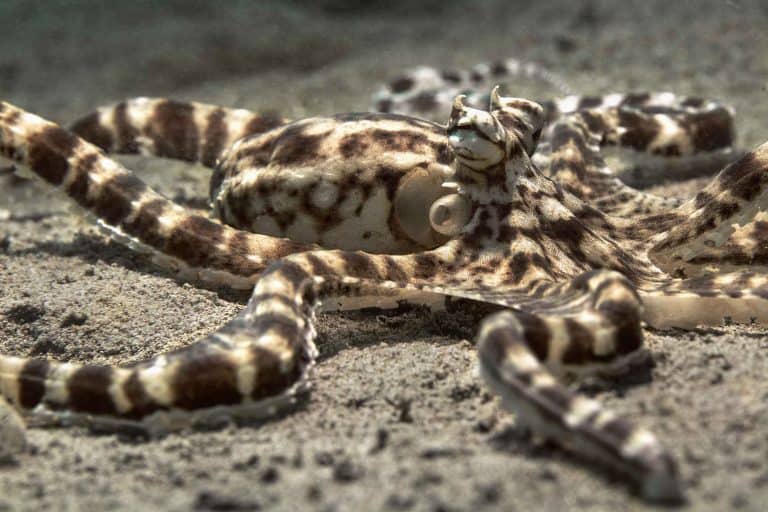
DIET
The silt or sand habitat is rich in benthic prey such as worms, echinoderms, crustaceans (crabs and shrimps), and fishes which also live in burrows, tunnels, and mounds. The mimic will blindly stick its long arms down holes in the sand in search for a tasty meal.
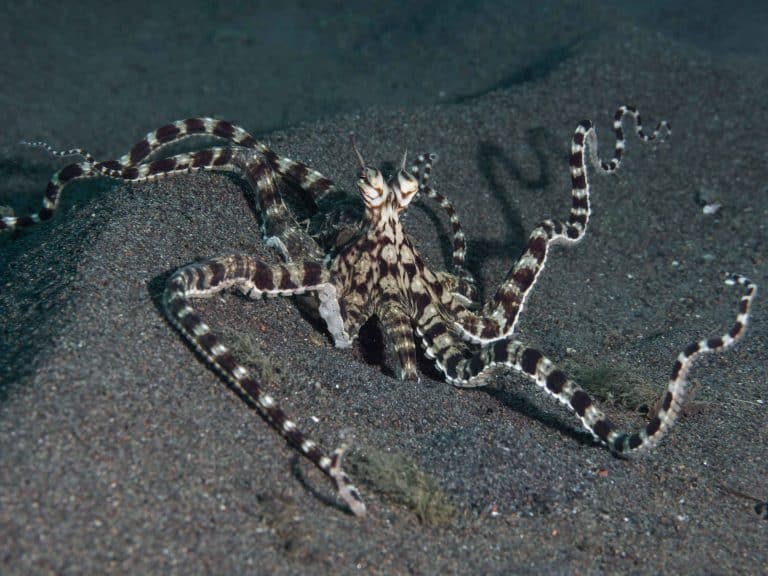
BODY PATTERNS AND BEHAVIORS
No underwater structure, no problem! This species belongs to a clade (group) of long-armed octopuses that have adapted to a life living in an open sand seascape. These animals have specialized behaviors to thrive in this strange environment that is empty of corals and other structures.
The color patterns of this species are variable from a uniform pale or dark, to mottled, to dramatically banded or high contrast body pattern. The dorsal mantle typically has irregular longitudinal white markings against a brown background.
Other key features of this species include: teardrop ring in mid to anterior dorsal mantle, white “U” on posterior dorsal mantle, arms with regular white bands against dark brown base color and arm white spots present in dark arm bands. The skin is relatively smooth with a rim of papillae around the mantle and paired sharply pointed, elongate papillae over each pronounced eye.
Until 2001, no cephalopod was known to imitate (mimic) toxic or dangerous animals. In addition, no animal group has previously been described that is able to switch back and forth between mimicry of different model organisms (not that kind of model!). This species is best known for its mimicry of toxic animals that co-occur in the same habitat that include: banded soles, sea snakes, and lionfish.
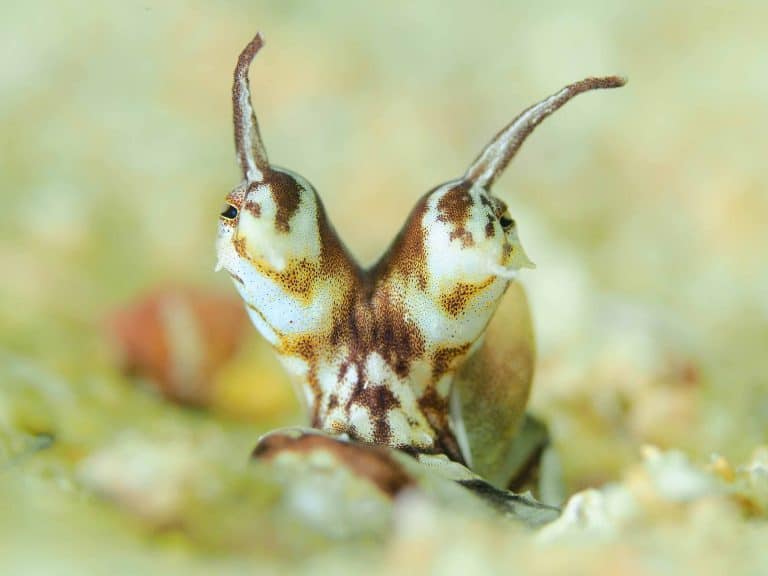
SHAPE SHIFTERS
This day-active octopus forages on sand substrates in full view of fish predators (like the golden trevally, Gnathodon speciosus); however, little is known about the specific predators of this octopus species. To confuse predators, this species has a few tricks up its sleeve [arms]. It forages by crawling along the soft bottom in drab brown colors to match its surrounding muck environment.
The mimic octopus, along with other long-armed species, uses its arm tips to probe down holes and flares its web to trap prey. In addition to these typical speculative foraging behaviors, individuals have been observed to forage through subterranean tunnels. An octopus would enter a tunnel completely and emerge from another hole up to 1 m (3 ft) from the entrance point!
When using jet propulsion to move faster, this species positions its arms to attain a flatfish shape and uses swimming behaviors similar to those of a flatfish (swimming durations, swimming speeds, and undulating body movements). In combination with a drab color, this octopus mimics non-toxic flounders and soles that a predatory fish may pass-up because they are difficult to eat. This flatfish swimming mimicry has also been described for other sand-dwelling species including Indo-Pacific White V octopus/ “blandopus”, Hawaiian Long-armed Sand Octopus, and the Atlantic longarm mimic octopus (Macrotritopus defilippi).
Unlike the other species, which remain camouflaged during flatfish swimming, the mimic octopus has also been reported to mimic visually conspicuous toxic animals through a high-contrast body pattern (dark brown and light cream) and postures or behaviors. Through flatfish swimming and high-contrast pattern, the mimic imitates the toxic flatflish (Pardachirus pavoninus and Zebrias spp.)
This species has also been observed swimming just above the sea-floor with arms trailing from the body, mimicking a poisonous lionfish (Pterios spp) with banded arms. To scare-off fishes, such as territorial damselfishes (Amphiprion spp.), the mimic octopus threaded six arms down its hole and raised two banded, curled and undulated arms in opposite directions. This mimicked the appearance of the venomous banded sea-snake (Laticauda sp.)
It is still unknown if the mimic octopus is actually toxic or bluffing. However, a flounder was observed trying to eat a mimic octopus and rejected it, which may suggests this octopus is unpalatable. Alternatively, this high-contrast body pattern may not be a “warning signal” but act as a disruptive pattern to break up the outline of the octopus’s body and inhibit visual predators to detect it.
Other distinct postures and behaviors have been observed and are open to interpretation. The mimic octopus was also observed sitting on top of sand mounds and raising all its arms above the body, each arm being held in a zigzag form. This may imitate large sand anemones (such as Megalactis spp.) that have stinging cells (cnidocytes).
A large female mimic octopus (arm span 600 mm or 2 ft!) was spotted swimming to the surface from 4 m (13 ft) deep. Once at the surface, the octopus slowly sank while undulating its arms. This behavior may be mistaken for jellyfishes that are found in the area.
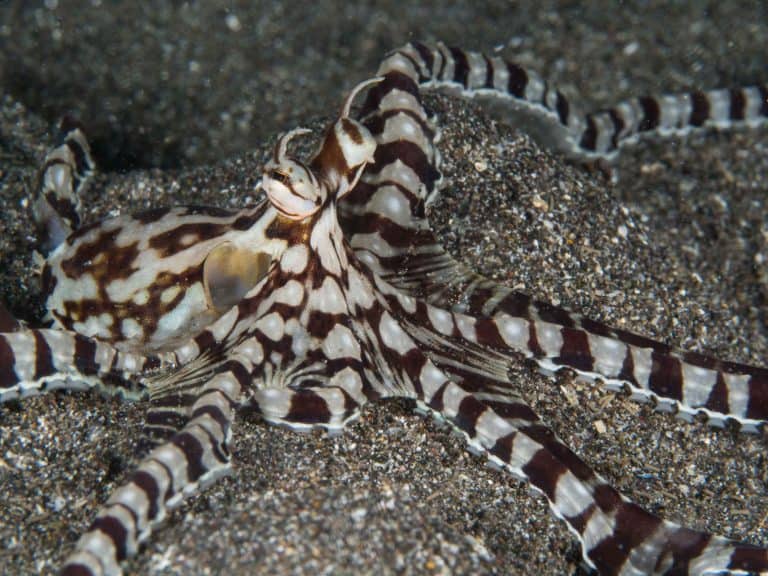
Hanlon RT, Conroy LA, Forsythe JW (2008) Mimicry and foraging behaviour of two tropical sand-flat octopus species off North Sulawesi, Indonesia. Biological Journal of the LinneanSociety 93:23-38
Hanlon RT, Watson AC, Barbosa A (2010) A “Mimic Octopus” in the Atlantic: Flatfish Mimicry and Camouflage by Macrotritopus defilippi. Biological Bulletin 218:15-24
Huffard C, Saarman N, Hamilton H, Simison WB (2010) The evolution of conspicuous facultative mimicry in octopuses: an example of secondary adaptation? Biological journal of the Linnean Society 101:68-77.
Jereb P, Roper CFE, Norman MD, Finn JK (eds) (2014) Cephalopods of the world. An annotated and illustrated catalogue of cephalopod species known to date. Volume 3. Octopods and Vampire Squids. FAO Species Catalogue for Fishery Purposes. No. 4, Vol. 3. Rome, FAO. pp.179-180
Norman, MD and Hochberg, FG (2005). The “mimic Octopus” (Thaumoctopus mimicus n. gen. et sp.), a new octopus from the tropical Indo-West Pacific (Cephalopoda: Octopodidae). Molluscan Research. 25(2): 57-70.
Norman MD, Hochberg FG (2006) The ‘Mimic Octopus’ (Thaumoctopus mimicus n. gen. et. sp.), a new octopus from the tropical Indo-West Pacific (Cephalopoda: Octopodidae). Molluscan Research 25: 57–70.
Norman MD, Finn J, Tregenza T. (2001) Dynamic mimicry in an Indo-Malayan octopus. Proceedings of the Royal Society of London – Series B: Biological Sciences 268: 1755–1758.
Our mission is simple: We work to inspire wonder of the ocean by educating the world about octopuses.
We work with scientists, educators, and artists to make a global impact.
OctoNation® is a 501(c)(3) Nonprofit Organization